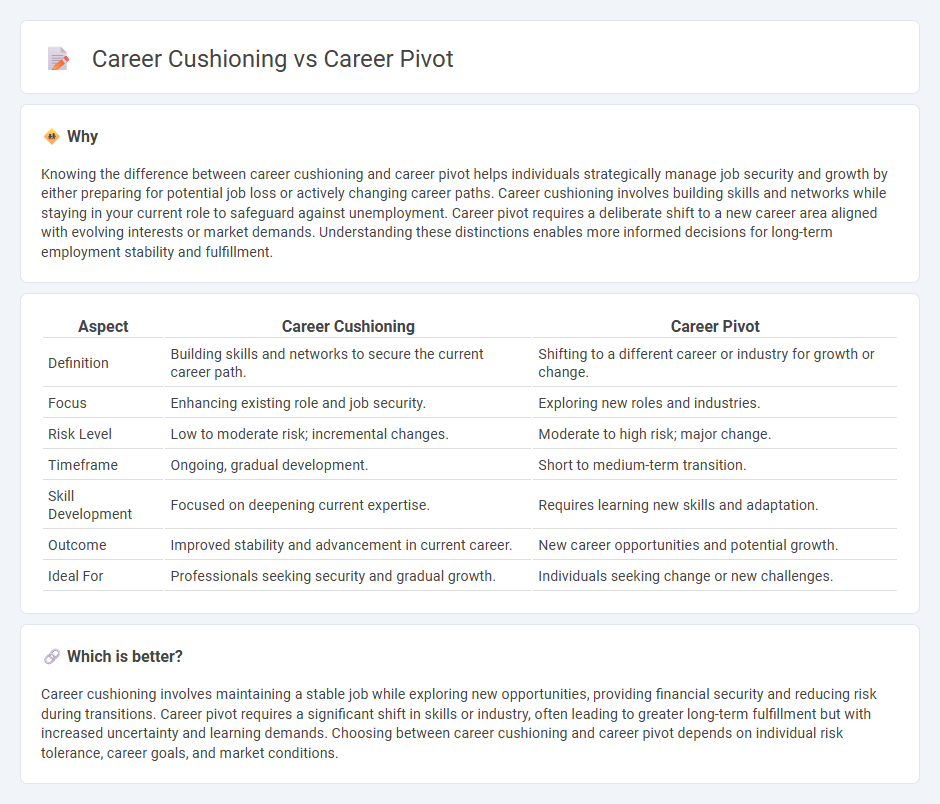
Career cushioning involves building skills and networks while maintaining current employment to prepare for potential transitions, ensuring stability and reduced risk during uncertain job markets. Career pivot refers to a deliberate change in professional direction, often requiring new qualifications or industries, to align with evolving personal goals or market demands. Explore effective strategies to balance career cushioning and pivoting for long-term professional success.
Why it is important
Knowing the difference between career cushioning and career pivot helps individuals strategically manage job security and growth by either preparing for potential job loss or actively changing career paths. Career cushioning involves building skills and networks while staying in your current role to safeguard against unemployment. Career pivot requires a deliberate shift to a new career area aligned with evolving interests or market demands. Understanding these distinctions enables more informed decisions for long-term employment stability and fulfillment.
Comparison Table
| Aspect | Career Cushioning | Career Pivot |
|---|---|---|
| Definition | Building skills and networks to secure the current career path. | Shifting to a different career or industry for growth or change. |
| Focus | Enhancing existing role and job security. | Exploring new roles and industries. |
| Risk Level | Low to moderate risk; incremental changes. | Moderate to high risk; major change. |
| Timeframe | Ongoing, gradual development. | Short to medium-term transition. |
| Skill Development | Focused on deepening current expertise. | Requires learning new skills and adaptation. |
| Outcome | Improved stability and advancement in current career. | New career opportunities and potential growth. |
| Ideal For | Professionals seeking security and gradual growth. | Individuals seeking change or new challenges. |
Which is better?
Career cushioning involves maintaining a stable job while exploring new opportunities, providing financial security and reducing risk during transitions. Career pivot requires a significant shift in skills or industry, often leading to greater long-term fulfillment but with increased uncertainty and learning demands. Choosing between career cushioning and career pivot depends on individual risk tolerance, career goals, and market conditions.
Connection
Career cushioning involves building skills and networks to safeguard against job loss, while career pivot refers to making a strategic shift to a new career path. Both concepts emphasize proactive career management and adaptability in response to changing job market demands. Together, they enable professionals to transition smoothly and maintain long-term employment stability.
Key Terms
Upskilling
Career pivot involves a significant change in job roles or industries, often requiring extensive upskilling to acquire new competencies, while career cushioning focuses on enhancing current skills to improve job security without leaving the present career path. Upskilling strategies in both approaches emphasize continuous learning through online courses, certifications, and hands-on experience to maintain relevance in a dynamic job market. Explore effective upskilling methods to determine which strategy best supports your professional growth and career goals.
Transferable skills
Career pivot involves making a substantial change in your professional path, often leveraging transferable skills such as communication, problem-solving, and project management to transition into a new industry or role. Career cushioning focuses on building a safety net within your current career by enhancing relevant skills and certifications to remain adaptable and marketable. Discover effective strategies to maximize your transferable skills for successful career growth and security.
Job security
Career pivot involves making a significant change in one's professional path to achieve long-term job security by acquiring new skills or entering a more stable industry. Career cushioning focuses on maintaining job security by building a safety net, such as side gigs or saving funds, while staying in the current role. Explore more strategies to enhance your job security through effective career management.
Source and External Links
HOW TO MAKE A CAREER PIVOT - DePaul University Resources - A career pivot is a planned and purposeful change in career direction, which can range from moving to a related field to something completely new and requires self-reflection, updating your resume, informational interviews, and a well-structured launch plan.
Your Ability to Adapt to Change--Without Starting Over - Pivoting careers involves translating your existing skills into a new context and showing how your transferable soft and hard skills apply, emphasizing that career changes are normal and not equivalent to starting from scratch.
How To Change Careers, According To 50 People Who Made A Pivot - Career pivots involve greater friction, disruption, and risk compared to linear career paths, but successful reinvention is possible by understanding the challenges and navigating emotional ups and downs thoughtfully.
 dowidth.com
dowidth.com